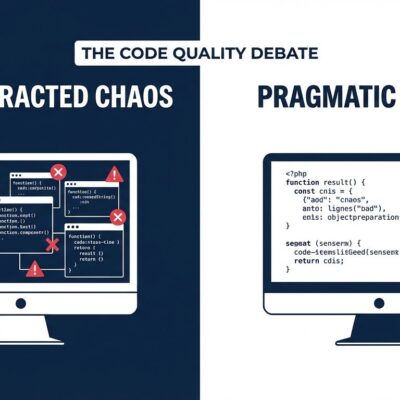
NVIDIA’s CUDA has become the GPU computing industry’s Internet Explorer 6 moment. It’s technically competent, well-optimized, and absolutely dominant. It’s also a proprietary monopoly that’s crushing competition, inflating prices, and stifling innovation. And just like with IE6, the developer community’s resignation to “that’s just how it is” enables the problem.
The Lock-In is Real
CUDA creates textbook vendor lock-in. Code written in CUDA runs exclusively on NVIDIA GPUs. Want to switch to AMD because their MI300X offers 192GB of HBM3 memory at a lower price? Too bad – your CUDA codebase won’t run. You’re looking at months of engineering work to port everything to ROCm, AMD’s alternative platform.
This isn’t theoretical. During the 2023-2024 GPU shortage, companies desperate for compute power had access to AMD GPUs but couldn’t use them. Their ML stacks were CUDA all the way down – PyTorch with cuDNN backends, TensorFlow optimized for CUDA, inference pipelines built on NVIDIA libraries. The hardware was available, but the software lock-in made it worthless.
The economics are brutal. Every developer faces the choice: write portable code that works across vendors, or write CUDA code that works today. CUDA has 15 years of optimizations, extensive libraries, and universal framework support. Portability means extra work, uncertain performance, and debugging on multiple platforms. Guess which one wins?
The result? NVIDIA controls over 80% of the GPU computing market. That’s not market leadership – that’s a monopoly.
Monopolies Kill Innovation
Here’s what monopoly pricing looks like: NVIDIA’s H100 GPUs sell for $30,000-$40,000 each. Cloud providers charge $2-$8 per hour. NVIDIA’s gross margins exceed 70%. There’s no competitive pressure to lower prices because there’s no meaningful competition.
AMD’s MI300X matches or beats H100 specs on paper. Intel poured billions into Ponte Vecchio and OneAPI. Both have under 10% market share combined. It’s not because the hardware is inferior – AMD’s compute capabilities are competitive. It’s because CUDA’s software ecosystem creates an insurmountable moat.
This is the innovation killer. AMD could have a superior architecture, but we’ll never know. Intel’s heterogeneous computing vision with OneAPI might be better, but it can’t get adoption. Every dollar invested in alternatives fights against 15 years of CUDA entrenchment. The best technology doesn’t win when switching costs are this high.
The most damning evidence? Tech giants with billion-dollar budgets prefer building custom silicon from scratch over dealing with NVIDIA’s monopoly. Google developed TPUs. Amazon built Trainium and Inferentia. OpenAI is reportedly working on custom AI chips. These companies looked at NVIDIA’s pricing and supply control and decided spending billions on chip development was the better option.
When building entirely new hardware is more attractive than accepting a vendor relationship, you’ve moved past “competitive advantage” into “monopoly problem.”
Developers Are Complicit
Here’s the uncomfortable truth: developers enable this. Every time we write CUDA-only code for a new project, we strengthen the monopoly. Every time we choose convenience over portability, we vote for vendor lock-in.
“But CUDA is genuinely better!” Yes. Now. After 15 years of monopoly investment. CUDA got better because everyone used it. Everyone used it because CUDA was better. This is the self-fulfilling prophecy of network effects.
Was CUDA always destined to dominate, or did our collective choices make it inevitable? When 85% of ML developers have only ever used CUDA and never tried alternatives, that’s not natural selection – that’s path dependency.
AMD’s ROCm has bugs and incomplete libraries. True. And it will continue to have bugs and incomplete libraries until enough developers use it to justify investment. Developers won’t use it because it has bugs. Chicken, meet egg.
The economic calculation is individually rational but collectively harmful. For any single project, choosing CUDA makes sense. At scale, across the industry, it creates the monopoly we’re now trapped in.
We’ve Broken Monopolies Before
Internet Explorer 6 held 95% market share in 2004. Microsoft’s proprietary ActiveX and VBScript extensions locked websites to Windows and IE. Web developers faced the same choice: build for IE’s dominant platform, or invest in standards that barely worked.
The developer community chose standards. Firefox was buggier than IE initially. Chrome was new and unfamiliar. But developers pushed for HTML5, CSS3, and ECMAScript standards anyway. They built progressive web apps that worked everywhere. They demanded better from browser vendors.
It took years. Microsoft fought it. Many developers said it was hopeless. But the monopoly broke. Today we have a competitive browser market driving actual innovation.
The lesson? Breaking monopolies requires accepting short-term pain for long-term industry health. It means supporting alternatives even when they’re not perfect yet. It means collective action overriding individual incentives.
What Developers Can Do
For new projects, consider portability from day one. SYCL offers vendor-neutral GPU programming. OpenAI’s Triton provides higher-level abstractions. Even abstracting CUDA behind your own interfaces makes future migration possible.
Companies should invest in multi-vendor GPU support now. The monopoly tax compounds – NVIDIA knows you’re locked in and prices accordingly. Today’s portability investment is tomorrow’s negotiating leverage.
Try AMD ROCm or Intel OneAPI, even if they’re only 90% as good as CUDA. That performance gap will close when people actually use these platforms. Your bug reports and feature requests improve them. Your adoption justifies AMD and Intel’s continued investment.
Demand better from framework maintainers. PyTorch and TensorFlow treat AMD backends as second-class citizens because developers demand CUDA performance. If we demanded parity, we’d get it.
The economic argument is straightforward: tech giants are spending billions building custom chips to escape NVIDIA’s monopoly. For most companies, investing in portability is far cheaper than building silicon.
The Choice is Yours
NVIDIA built CUDA through genuine innovation and years of investment. They earned their market position. But dominance became monopoly, and monopolies harm industries even when initially earned through merit.
The developer community broke Microsoft’s web monopoly by demanding standards and supporting alternatives. We can do it again. It requires seeing beyond individual project constraints to industry-wide effects. It means valuing long-term competition over short-term convenience.
Or we can accept the monopoly, pay the monopoly prices, and watch innovation die behind NVIDIA’s moat. That’s also a choice.
Your next project’s GPU computing strategy isn’t just a technical decision. It’s a vote for the kind of industry we’ll have in five years. Choose accordingly.



